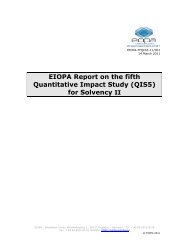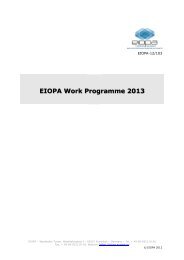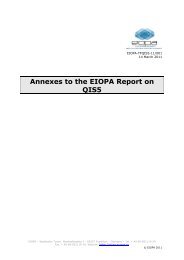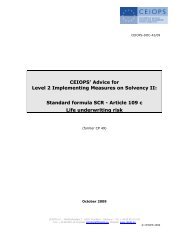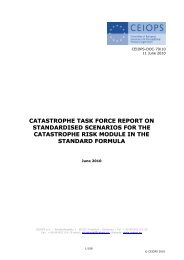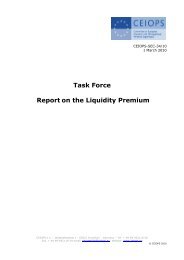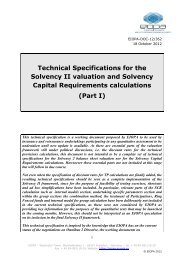Answers to the European Commission on the ... - Eiopa - Europa
Answers to the European Commission on the ... - Eiopa - Europa
Answers to the European Commission on the ... - Eiopa - Europa
Create successful ePaper yourself
Turn your PDF publications into a flip-book with our unique Google optimized e-Paper software.
• trend uncertainty: arises from <str<strong>on</strong>g>the</str<strong>on</strong>g> difficulty in accurately<br />
assessing <str<strong>on</strong>g>the</str<strong>on</strong>g> future directi<strong>on</strong> of assumpti<strong>on</strong>s (e.g. rising life<br />
expectancy) in future years.<br />
10.53 When a policy lapses, <str<strong>on</strong>g>the</str<strong>on</strong>g> insurer pays <str<strong>on</strong>g>the</str<strong>on</strong>g> surrender value and<br />
'receives' <str<strong>on</strong>g>the</str<strong>on</strong>g> technical provisi<strong>on</strong> that is released by <str<strong>on</strong>g>the</str<strong>on</strong>g> policy’s<br />
terminati<strong>on</strong>. Therefore, <str<strong>on</strong>g>the</str<strong>on</strong>g> treatment of lapse risk in <str<strong>on</strong>g>the</str<strong>on</strong>g> SCR str<strong>on</strong>gly<br />
depends <strong>on</strong> how lapses are dealt with in evaluating technical<br />
provisi<strong>on</strong>s. If when valuing liabilities, surrender floors are c<strong>on</strong>sidered<br />
<strong>on</strong> a c<strong>on</strong>tract-by-c<strong>on</strong>tract basis, <str<strong>on</strong>g>the</str<strong>on</strong>g>n an increase in lapse rates<br />
presents no additi<strong>on</strong>al risk. If not, <str<strong>on</strong>g>the</str<strong>on</strong>g> insurer is at risk of higher lapse<br />
rates if surrender values are higher than policy technical provisi<strong>on</strong>s.<br />
But lower lapse rates may also be unfavourable <str<strong>on</strong>g>to</str<strong>on</strong>g> <str<strong>on</strong>g>the</str<strong>on</strong>g> insurer if<br />
surrender values are lower than technical provisi<strong>on</strong>s of those particular<br />
c<strong>on</strong>tracts and lapse assumpti<strong>on</strong>s are included in <str<strong>on</strong>g>the</str<strong>on</strong>g> calculati<strong>on</strong> of<br />
technical provisi<strong>on</strong>s <strong>on</strong> a portfolio basis.<br />
10.54 Unanticipated lapse rates may also prevent an insurer from recovering<br />
initial policy acquisiti<strong>on</strong> expenses from future premiums. Acquisiti<strong>on</strong><br />
expenses may be recognized implicitly in financial statements through<br />
<str<strong>on</strong>g>the</str<strong>on</strong>g> use of modified net level premium valuati<strong>on</strong> methods. But such<br />
implicit methods do not currently include any provisi<strong>on</strong> for<br />
unfavourable variati<strong>on</strong>s in lapse rates. Under a 'best estimate + risk<br />
margin' valuati<strong>on</strong> approach, unfavourable variati<strong>on</strong>s should be partly<br />
included in <str<strong>on</strong>g>the</str<strong>on</strong>g> risk margin unless this risk is excluded from <str<strong>on</strong>g>the</str<strong>on</strong>g><br />
valuati<strong>on</strong> of technical provisi<strong>on</strong>s.<br />
- Choice of structure for modelling approach <str<strong>on</strong>g>to</str<strong>on</strong>g> underwriting risk<br />
10.55 A scenario-based modelling approach <str<strong>on</strong>g>to</str<strong>on</strong>g> underwriting risk would require<br />
<str<strong>on</strong>g>the</str<strong>on</strong>g> definiti<strong>on</strong> of a set of scenarios that adequately describe any<br />
adverse development of <str<strong>on</strong>g>the</str<strong>on</strong>g> underwriting result of <str<strong>on</strong>g>the</str<strong>on</strong>g> insurers’<br />
portfolio. Given <str<strong>on</strong>g>the</str<strong>on</strong>g> heterogeneity of underwriting risk, even within<br />
established 'classes' of insurance business, relying solely <strong>on</strong> such an<br />
approach does not seem feasible in <str<strong>on</strong>g>the</str<strong>on</strong>g> c<strong>on</strong>text of <str<strong>on</strong>g>the</str<strong>on</strong>g> standard<br />
formula.<br />
10.56 However, by nature of <str<strong>on</strong>g>the</str<strong>on</strong>g>ir c<strong>on</strong>structi<strong>on</strong>, fac<str<strong>on</strong>g>to</str<strong>on</strong>g>r-based models may be<br />
less able <str<strong>on</strong>g>to</str<strong>on</strong>g> predict extreme, catastrophic events, which may c<strong>on</strong>stitute<br />
an important source of risk in life insurance. This may also be <str<strong>on</strong>g>the</str<strong>on</strong>g> case<br />
for lapse risk since <str<strong>on</strong>g>the</str<strong>on</strong>g> impact <strong>on</strong> <str<strong>on</strong>g>the</str<strong>on</strong>g> technical provisi<strong>on</strong>s of a higher or<br />
lower than expected lapse rate may not be c<strong>on</strong>stant in time. The<br />
impact of this kind of events <strong>on</strong> <str<strong>on</strong>g>the</str<strong>on</strong>g> risk situati<strong>on</strong> of <str<strong>on</strong>g>the</str<strong>on</strong>g> insurer may be<br />
better captured by stress and scenario techniques than by static fac<str<strong>on</strong>g>to</str<strong>on</strong>g>rbased<br />
models.<br />
92






